Go to Page
Inishcaltra Parish - A description of the notable objects therein.
Sir,
Inishcaltra parish lies in the South end of the barony of Leitrim in the County of Galway on the South west end of Loughderg about 9 miles S.S.E. of Woodford and about 4 miles N.E. of Scarrif {Name book, p. 1}.
It received this name from (the island of) Inishcaltra, Inis Cealtra ({the island of Keltair}, which goes commonly now by the name of Holy island, and is situated on Loughderg 1½ mile S. West of Mountshannon.
On this island, stands a Round tower (see vol. of sketches), which is locally Called Clogár, and is a splendid construction of large stones, bearing strong resemblance (in this respect) to the Round tower of Roscrea. It is 45 feet 8 inches in circumference (47ft. 0in at base - J.O'D) within 4 or 5 feet of the ground. The door, which is on the East side, at the height of 12 feet (10..7., J.O'D.) from the ground, is 5 feet 2½ inches high, 2 feet 1/3 inch {not 2 inches certainly} broad in the lower part (externally), and circular at top.
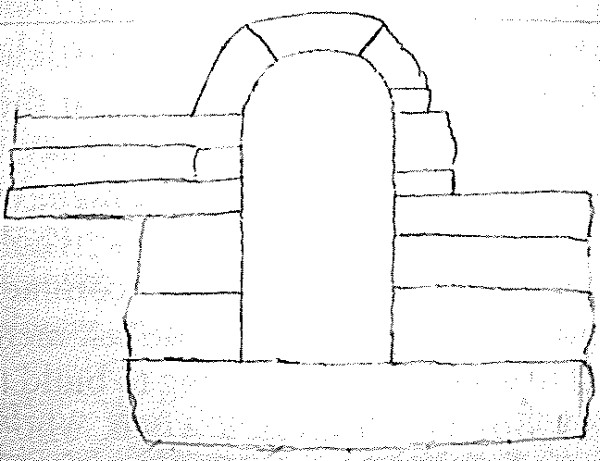
The diameter inside is 7 feet 11 inches, and the wall is 3 feet 3 inches thick.
7feet. 11inches. diameter
3feet. 3 inches thickness of wall
3feet. 3 Do.
14feet. 5inches. diameter including thickness of the wall.
The lower part of the tower inside, is filled up with clay as high as the door. At the depth of three feet below the surface of this clay, long stones jut out, it is said, from the wall of the tower, so as to form a floor {or a support for a floor?}.
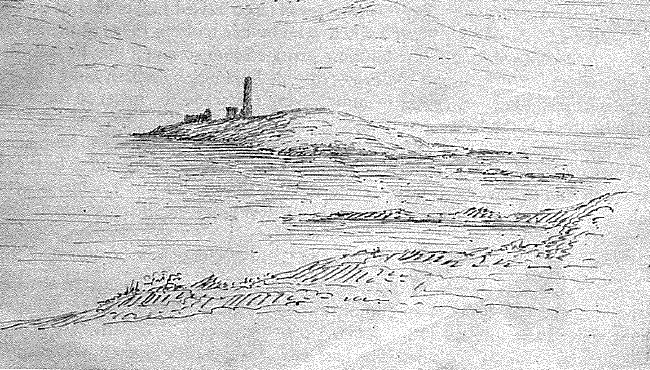
Henry Boucher, the grandfather of Henry Allen, who lives at the lake opposite the island, and who went with me into it, saw an iron door on this tower. The traces where it was fastened (hung), are (still) visible to the left, as one enters; and the traces where it was bolted when closed, are visible on the right.
There is a bit of iron said to have been a part of a 'hold fast', inserted in a stone on the left as one enters. It is supposed to have been fixed in the stone at the time (period) of the building of the tower. Most of the stones, of the door, all which are chiseled, extend the whole breadth (thickness) of the wall.
Henry Boucher, who lived to the age of ninety six, or nearer to one hundred years, and is dead only four or five years, saw 3 floors perfect in this tower.
Some of the stones that supported the (now) lower floor are still seen jutting out of the wall, at the height of about 13 feet above 'the clay floor' which is on a level with the door.
Over these stones, and two or three feet above them, there is on the North side, a quadrangular opening, apparently 3 feet high, and 2 feet broad, which admitted light to the floor that was placed over them. This opening is pointed on the outside.
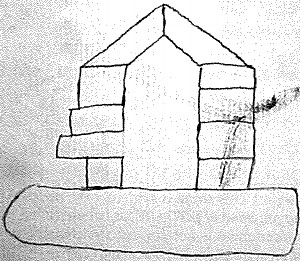
[Hand of J.O'D:]
This angle is too obtuse; See Wakeman's drawing of this tower.
The traces of the position of three other floors, are as yet observable inside the tower, opposite the second one of which, that was placed (next) above the first one just noticed, there is on (the) tower (exactly over the door), a quadrangular opening apparently 1½ foot high and 1 foot broad. On the South side, opposite the third floor, is also a quadrangular opening. And there is one of a similar form on the West side, opposite the fourth floor and near the top. The tower has no beannchobhar now on it, and is opened at the summit. It is ? feet high.
The local tradition is that this tower was never raised higher than it is at present, and assigns as the cause of this - the craft of a witch, who by her scoffing
at the architect that (who was) busily engaged in working at the building, irritated him so much that he leaped off the top of it, on the ground and struck her on the head with his hammer, by which blow she was metamorphosed. The people now show her "done in stone", lying (close) to the tower to the west side, and retaining (still) the track of the hammer.
The stone which is shown, is of a blackish colour; and appears to have been fitted out (for), or used in some building. (This stone is evidently the pedestal of a Cross, J.O'D.) There was an incision made in it, which is said to be the track of the hammer. The witch said to have been thus transformed, is the Cailleach na Sioghbhruidheacht = fairy hag, who is spoken of in connection with Illáánmore in the last letter.
SAINT CAIMIN'S CHURCH
Stands in ruins next the round tower to the North East of it. Attached to the East end of it, are two portions of the side walls of an edifice, locally called St. Columb Kille's (chapel) (what is here called St. Columbkille's Chapel is only the choir of St. Caimin's Church), still remaining, which were, it appears, 8 (18 ?, J.O'D.) feet (This measurement is not correct; the choir of St. Caimin's Church is 15 feet 3 inches long and 12 feet 7 inches broad when measured on the inside, J.O'D.) in length originally. These walls were built with quadrangular stones, all chiseled. The East gable {of this little chapel}, was entirely destroyed. Within it, are shown the foundation stones of an altar. (The nave of the Church of St. Caimin is 34 feet long and 25 broad. See Wakeman's ground plan of it. J.O'D.)
On the East gable of Saint Caimin's Church, there is an arch way ({This is its choir arch}, J.O'D.) common to itself and this little Chapel. It is 10 feet broad at the ground, about 12 feet high; of (semi-) circular form, and built with chiseled stones supported on 'groups' of round
pillars of ({round pillars of cut stone, J.O'D.}) masonry 4½ feet high, on the top of which, where the arch turns, are placed stones of quadrangular form, exhibiting ornamental Carvings. Each side consists of five combined pillars, two placed directly under the arch, one on the side next Columb's Chapel ([Hand of J.O'D.:] i.e. the choir), and two on the side next Caimin's Church {i.e. the nave (J.O'D.)}.
This Church is 30 (34, J.O'D.) feet long and 20 (25, J.O'D.) feet 10 inches (21 ft.) broad. At the distance of 2½ feet from the just mentioned archway, there is a window on the South side wall; (which is on the inside) 4 feet 3 inches from the ground; 2½ feet broad in the lower part; 4½ feet high; of circular form, and built with chiseled stones.
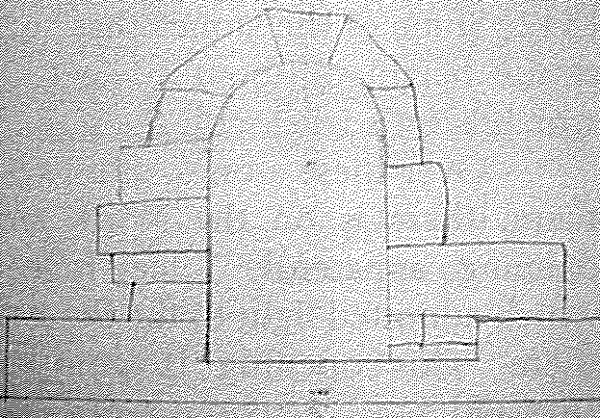
On the outside this window is about 6½ feet from the ground; 2 feet high and 1 foot broad.
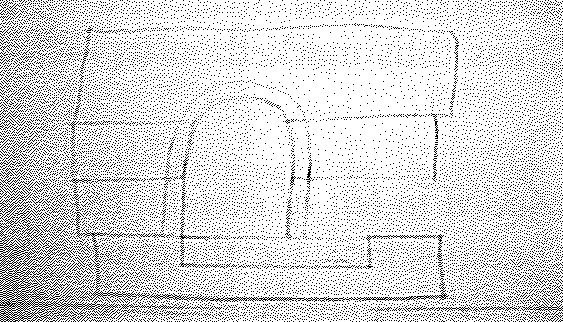
There is another window on the same wall, which is quadrangular; 5½ feet from the ground, 2 feet broad and 3½ feet high.
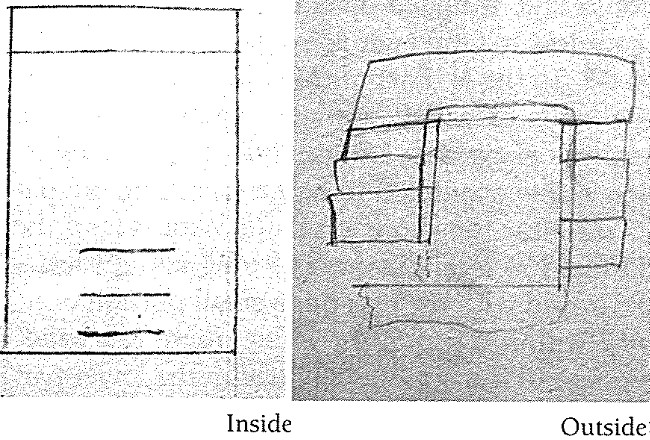
The door which was on the West gable of this Church, was built with ornamentally Chiseled stones, six feet of which in height remain still visible on the North side; which (part) alone can be regarded as in any degree of (in) a state of preservation; for all the rest of it is battered. Its breadth and form are not well ascertainable. (This doorway was certainly semicircular and exactly like that of Inis Teampull na naomh on Incha-Goill in Lough Corrib, J.O'D.).
In the South side-wall also, near the West gable, on the inside, there is a monument placed, which exhibits some figures of animals, with this inscription under them.
17 23 VULNERATUS NON VICTus. JA: GRADY REPAIRED THOS, CHURCHES AND MONUMENT TO THE GRACE AND GLORIE OF GOD
Henry Boucher above mentioned saw a bell on the East gable of this Church.
[In pencil: It was brought to Killaloe where however they could make no use of it, for it would not ring. It was shortly afterwards buried in the ground. ([In pencil in left-hand margin:] On Caimin's Day it used to toll spontaneously.)
To the North East of this church, stands a small portion of a wall, 7 feet long and 6 feet high, which is said to have belonged (to) [a] small chapel, whose vestiges are still observable. It was originally 12 feet long and 10½ feet broad. No (particular) name exists, as far as I could learn, for this little edifice. (This is Teampull na bh-Fear Gonta.) A flag stone lies sunk in the ground, to the North East of it, in a horizontal position, with a Cross thus marked on it. -
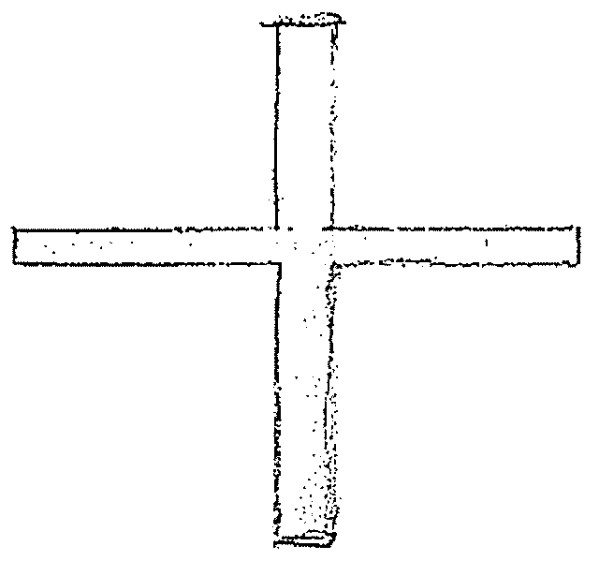
[Added to left of sketch: This is called Teampull na bh-Fear n-Gonta, i.e. the church of the wounded men, i.e., in which men slain in battle, and who would not be admitted into respectable burial places, were interred, J.O'D.]
There was an attempt made, it is said, to carry away, this stone to Clonrush; but no human power could take it up, to place it in the boat, which was in readiness to convey it across the lake.
To the N. East of this latter little chapel, was a confession church ({or} house), small portions of the walls of which, are still observable. And to the North East of this Confession Church, lie the vestiges of another edifice, which is supposed by some persons, to have been a dwelling house; but is generally considered to have been a church. No particular name is now known for it.
Near the shore, on the South West side of the tower, St Mary's Church stands in ruins, which is 55 feet (54 feet 9 inches, J.O'D.) long and 23 feet (22 feet 2 inches, J.O'D.) broad. The East gable is destroyed with the exception of a small portion of it, attached to the North side wall. On the South side wall within 2 feet of the East gable, there is a window, which is on the inside 5 feet from the ground; 4½ feet (5 feet 1 inch, J.O'D.) broad in the lower part; no less than 8 feet (7 feet 11 inches, J.O'D.) high, and is arched in the upper part (round headed inside and outside) with masonry of chiseled stones.
On the outside it is 9 feet from the ground, 4 feet 3½ inches (4 feet 5 inches, J.O'D.) high, and near 6 inches broad.
[Added in a different hand: It is broader at the top than at the bottom.] It is 7 inches broad near top and only 53/4 inches at the top. This window must have belonged to an older church, and seems to have been inserted into this wall about 3 centuries since, J.O'D.
The sidewalls of this Church are at least 16 or 17 feet in height. There was a door on the South side wall towards West gable, 5 feet 2 inches broad and 8 feet high. It is now stopped up with mason work; and its form at top is still observable very clear- -
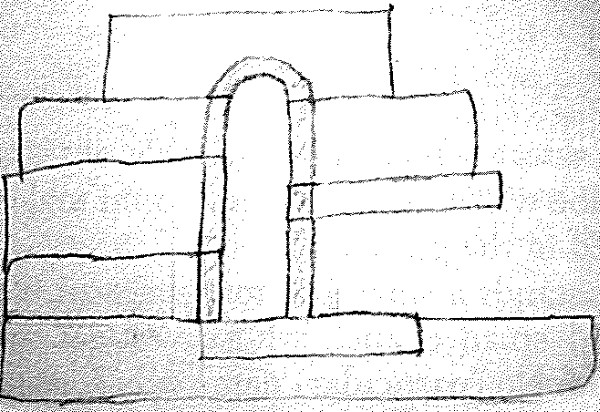
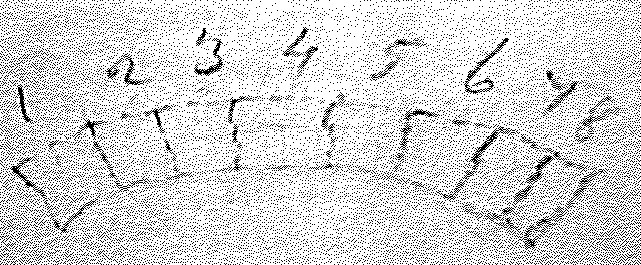
The door on the West gable is constructed with Chiseled stones. It is 3½ feet broad in the lower part; 6 feet 8 inches high, and nearly pointed
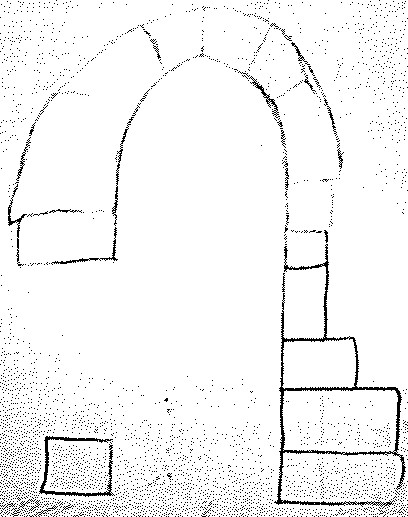
[Added to right of sketch: This doorway is scarcely 5 centuries old, J.O'D.]
[Added to right of sketch: The walls of this church are 2ft. 9in. in thickness, and built of quarried and field stones mixed, J.O'D.]
There was it appears, another doorway on the North side wall near East gable, which is now filled up with masonry. It was (apparently) similar to the one on the South wall.
On the South side wall inside the Church, there is placed a stone representing the form of a human head with a chaplet on it.
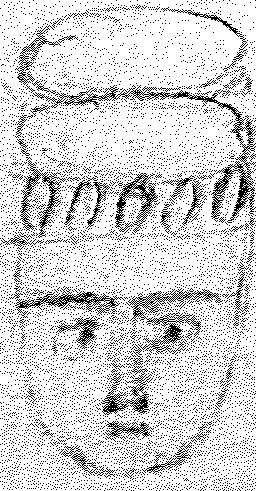
And under it on a stone monument, three lions rampant are shewn in front of which, is the form of a dagger with a hand holding it. {Fig. 77]
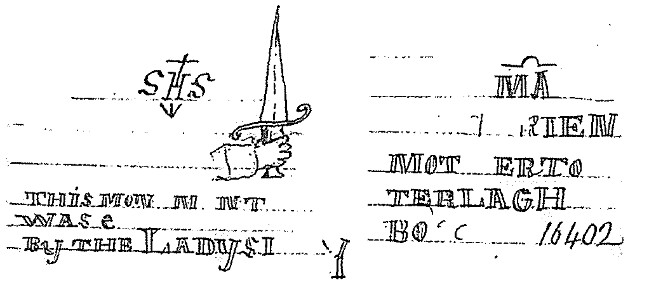
To the left of this monument, a stone is placed in the side of the wall, on which, a human face is rudely expressed.
At some distance from Saint Mary's Church to the North, stand the ruins of a small Chapel, which is called 'baptism house'. It was originally 20 feet long; the East gable, 18 feet of the North sidewall, and about 7 feet of the South sidewall attached to the East gable, remain.
On the East gable is a window, which on the inside commences within 2½ feet of the ground, is near 3 feet broad in the lower part, and 3½ feet high. It is broken down at top on this side. On the outside it is 2 feet 2 inches high and 6 inches broad, and is of a quadrangular form. This gable was prostrated by the memorable storm of the 6th of January, 1838. How soon a piece of writing becomes an antiquity! - J.O'D.
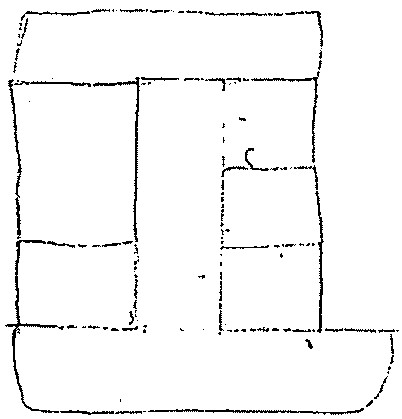
Close to the East gable, there is a window on the South sidewall, which on the inside, is 2 feet from the ground; 3 feet broad in the lower part. The upper part was totally destroyed on both the inside and outside.
This was 6 inches broad, and about 2½ feet high on this latter side. It was, as well as the East gable window, constructed with chiseled stones.
Directly to the West of the round tower, is the site of a very small Chapel, which is called St. Michael's, 6 feet long, 4½ft. or 5(?) feet broad. The door way on the West end is 22 inches broad. The vestiges of the foundation afford the means of ascertaining the extent as given here. The precincts within which, this foundation is seen, is called Garaidh Mhicheail. i.e. St Michael's garden.
We return now to St. Columbkille's chapel, a few yards distant to the South East (corner) of which, the spot, where the twelve Saints are interred, who founded originally the Churches on the island, is pointed out. A stone without an inscription
standing here marks the place, in which, is lying horizontally also another, which covers the grave. The latter is nearly overspread with encroaching (overgrowing) earth and grass.
There is a stone (see sketches) lying to the East of the tower and near the shore which measures 4 feet on the longest side, 3 feet on another side, and 2½ feet at both ends. It lies in a horizontal position in this manner.
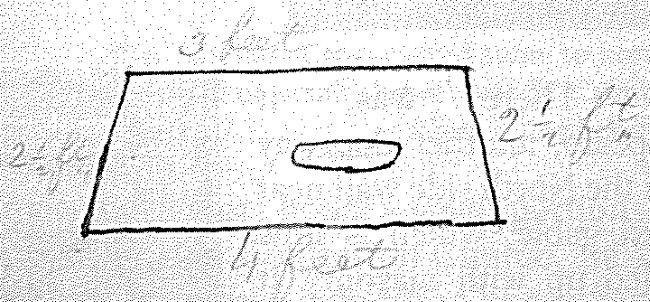
[Added to left of sketch: This is certainly the pedestal of a cross, J.O'D.]
This stone is 8 or 9 inches high. In the surface, is cut a cavity in the form here marked, which is 21 inches long, 4 inches broad and 7 inches deep. This cavity was filled up by a stone which was formed so as to adapt itself into it, and was called a 'tongue', which is now lost (not to be found).
These letters are inscribed on the surface where it is 4 feet in length, and are preceded by a cross. [Fig. 80]

[Added to left of sketch: These letters are most beautifully cut, J.O'D.]
The ![]() appears in this manner to the eye
appears in this manner to the eye
- but ![]() ; these affixes, I think, are not to be considered as artificial and coeval with the letter; though they appear as such, for the stone is of so unsolid a quality, that these marks are probably vacuities, caused by the removal of small particles accidentally out of the surface of it.
; these affixes, I think, are not to be considered as artificial and coeval with the letter; though they appear as such, for the stone is of so unsolid a quality, that these marks are probably vacuities, caused by the removal of small particles accidentally out of the surface of it.
This is only the fragment of an inscription; the remaining part of it must have been on the shaft of the cross which stood in this pedestal, J.O'D.
Lady well is situated near the shore to the N. East end (corner) of the large Church called St. Mary's.
A Patron used to be held here annually 4 days - Friday and Saturday before Whitsunday, on which day and on the following Monday, it was continued. No assemblage of persons, was allowed here those years past, on this occasion in consequence of the outrageous conduct of some ill-behaved young rascals, who were wont to seize the opportunity of providing (for) themselves, fresh consorts for the ensuing year, by carrying off 'by open force', from the island, young girls, in spite of all their friends and relations.
Three brothers of a family of the O'Briens, who resided in the County of Clare, within view of the island, used to frequent the patron, at which they conducted themselves, it is said, in a most disgraceful manner. On one occasion, one of them carried off a young girl by force from it; whom he afterwards detained till, he had three children by her. The neighbours state that no law corrected such detestable conduct at the time.
The Station was commenced at Lady Well; and the performers went round the extremity of the island, 1 mile in the circuit, 7 times, equal 7 miles. The short rounds were commenced at a Station monument {a little mound of earth and stones} lying 35 yards to the West of the round tower.
They went round this monument 7 times and proceeded through the door on the west gable of Saint Caimin's Church, and as far as the altar in St. Columb's Chapel. They went this length seven times from the monument just mentioned, and at the commencement of every seven times of these; they went round the monument itself seven times. They went round St. Caimin's Church 14 times; the tower and all the churches around it, being included in the rounds. They went round a station monument at the end of St. Caimin's Church; either the one {a little mound of earth} immediately at the S.W. corner or the one {also a little mound of earth} within a few yards of the N[?]. West corner of it. They also went 7
times round Gáraidh Mhicheáil, S. Michael's Garden; and 7 times round the bank of earth about S. Michael's Church, and 7 times round the Church itself, and 7 times round a large flag stone lying at it, on which stone, they finally (i.e., after having gone round it the 7 times) impressed kisses. They went 7 times round Saint Mary's Church, and 7 times round the baptism Church. They finished at the well and drank of its water.
This is the most accurate description I could get of the mode in which the Station on the island was performed. I could not get a minute description, which would detail the number of prayers repeated during the process of the rounds. Nor am I certain that the description
I have given here, affords a correct view of the order of the process. I introduced it here merely to show what Station monuments were made use of.
The old walks which were formerly gravelled over, on this island, are now covered with grass, and still traceable. Henry Boucher the grandfather of Henry Allen, both (of) whom are mentioned above, saw rows of trees planted along the sides of them. The principle road is still observable leading from the lake to the Churches in a Southern direction. It is said there is a road {or Causeway} extending opposite or near the Western extremity of this road, a distance of some perches from the island into the lake.
A person could safely walk on it in Summer time, when the weather is dry. It is supposed that this road, formerly connected the island with the mainland.
[In left-hand margin beside this paragraph: See hereafter] Annexed are the words of a discourse that took place (was held) between Guaire Aidne, Cumain Fota (the tall) and Camain of Inisceltra in the large Church of Inisceltra, which was founded by Saint Camain. This discourse is preserved in a M.S. T.C.D. H.2.16. page 795. It appears there is a translation either of this or of another version of it, given in Latin by Colgan, in the Life of Saint Caminus Abbot of Inis Keltra at XXV of March, AA S.S. p. 746, Col: a. I wish we could have the satisfaction of Collating the words of Colgan's translation with those of the MS. as here given.
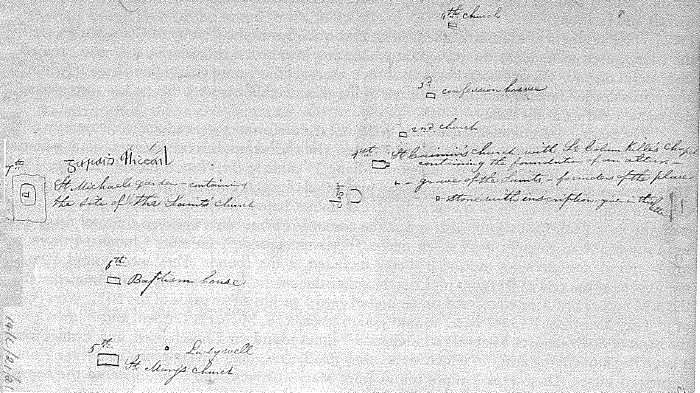
On the inside page, the sites of the seven churches on the Island are laid down in their positions with respect to the round tower. It is intended merely to show the sites with the names, of as many of them churches, as are locally known. There is no attempt made to point out their respective distances; even the line of direction in which they are here placed cannot be said to be accurate; but it may serve as a guide for having all those requisites correctly made; and will show the churches and the other monuments to which names are to be attached. These names must also be understood as gotten from local information and not from any other source.
[Hand of Patrick O'Keeffe]
OF S. CAMINUS, ABBOT OF INIS-KELTRA, BARONY OF LETRIM
XXV of March. AA.SS. p. 746, Col: a.
Some of the ancient Hagiologists place the birth-day of Saint Caminus, who is also called by some Caninus (1), on this day, but others on the preceding day
The holy man flourished in virtues and miracles about the year of salvation 640. He was the son of Dima (3) of the race of Enda Kenselach, and the most noble stock of the Kings of Leinster; and he had for his step-brother (germanum, maternal brother) that Guaire (4), the son of Colman, King of Connaught, whom our Historians extol with wonderful encomiums on account of the excellent endowments of his mind, but especially his distinguished liberality. For they say that the mother of both was Cumania (5), otherwise Mumania, the daughter of Dalbronius, a woman of very celebrated name on account of {her} numerous and holy offspring, of whom (i.e. Cumania) elsewhere. But this Caminus, through a desire of a more abstracted life, betook himself to a certain island lying in Lake Derg-dherc on the confines of Thomond and the County of Galway, commonly called Inís-Kentra ({Inis-Keltra in corrigenda}); and there when sequestered for some years from the intercourse of men, he, in continual
castigations of his own flesh, in fasts, watching, and the diligent contemplation of heavenly {subjects}, had undergone a severe conflict with the world and the devils, at length the fame of his virtues and most austere institute betraying him, he so attracted almost innumerable disciples to the admiration and imitation of him, thaua in the end the number of his sons increasing daily, he erected there a noble and spacious Monastery; in which he eminently trained (established) up a numerous paternity of Monks as if in a sort of Angelical life, and most holily governed {them}. This Monastery became afterwards so great {an object} of veneration on account of the reverence {paid to its} most holy founder and the almost innumerable multitude of Saints resting there (in it), that it was deservedly reckoned among the principal Monasteries of this island, and is thence considered an inviolable asylum and City of Refuge.
Illustrious is the testimony which S. Aengus, or his old Scholiast in the glosses or additions to the Festilogium Aengussianum at the 25th of March, gives of this holy man's severity of life, and admirable more than imitable study of
mortification, in these words: Whilst on a certaín day S. Caminus, and S. Cumineus surnamed the Tall (6) were in the Church which S. Caminus founded in the island called Inis- Keltra, situated in Lough Derg-dherc, spiritually discoursing of matters concerning the soul, with Guaire Adhne, King of Connaught; &c, &c. ***
{p. 746.b} These from the cited Scholia, to which there do not occur other things which I can subjoin (add), unless that this distinguished despiser of the world, and inexorable chastiser of his flesh, is said to have published (7) Commentaries on the Psalms; of which, we have beheld with our eyes, what he has commented on the 119th Psalm, written as tradition says, with his own hand. He departed in the year of the Incarnation of the Lord (8) 653, and he was buried in his own Monastery of Inis-Keltra; in which also that his birthday is celebrated with festivity on (9) this 25th of March, S. Aengus and S. Maelruana hand down in the Martyrology of Tallaght; but others on the 24th (10) of the same.
NOTES:
{p. 747, col: a} 1. Quibusdam Caninus. Thus the Carthusian Martyrol. Ferrarius, Canisius, & the Calendar of Cashel below.
2. ***
3. Patre natus Dima. Thus Selvacius hands down in his little work on the genealogy of the Saints of Ireland chap. 18, and the Sanctilogium genealogicum chap. 20. S. Caninus, it says, the son of Dima, the son of Fergus, son of Ailill, son of Dathias, son of Crimthann, son of Enda Kenselach, son of Lauradius, son of Bressal Belach.
4. 5. Fratrem habuit germanum Guarium &c. Thus the Four Masters in the Annals at the year 662 saying: Guaire Aidhne the son of Colman, King of Connaught died. Cumania the daughter of Dallbronach was the mother of him and of S. Camin of Inis-Keltra; of whom (i.e. Cumania) an old author writes, Cumania the daughter of Dalbronius, the mother of Camin and Guaire; and from her seed are said to have proceeded seventy seven, surely Saints, as is collected from the life of S. Forannan given at the 15. Febr:
{Col: b} 6. S. Cumineus cognomento Longus. He was Bishop of Clonfert, and died in the year 662 on the 2nd day of December, according to the Four Masters, but on the 12th of November Marian & others place his birth-day.
7. Commentarios in Psalmos. Thus Ware lib. I. c. 3. Saint Camin, he says, is supposed to have written on the Psalms. For among the books of the Francíscans of the Convent of Donegal are had his most ancient leaves (schede) on the 119th Psalm, which tradition says, were written with his own hand.
8. Anno 653. Thus Ware at (in) the same place. he died, says he, at Inis-Celtrae, alias Iniscalatara in the year of salvatíon 653. Thus also the Annals of Innisfallen cited by the same.
9. Hoc die 25 Martii &c. At the 24th of March he is mentioned by Marian Gorman. Caminus, he says, of Inis-Keltra; by Maguire in the same words. The Calendar of Cashel S. Caminus or Canius of Inis-Keltra. Also the Martyrologium Carthusianum, Petrus Canisius, and Philipp Ferrarius in their Martyrologies at the same day call him Saint Caminus Confessor. But that his birthday is celebrated on the 25th of March, S. Moelruana, and S. Aengus hand down in their Martyrology of Tallaght written about eight hundred and sixty years since, where they also add that his mother was called Cumania; and the Scholiast of the Festilogy of Aengus, in the words above cited, and the Martyrology of Donegal.
{vide Muc-inis infra}
OF S. DIMAN BISHOP OF CONNOR
VI. Of January {AA.SS. p. 16.}
This S. Diman lived at the time that the Irish differed from the Romans with regard to the time of celebrating Easter. Wherefore for the sake of settling some disputes which arose on the subject and gaining over the Irish to the Roman custom Pope John the Fourth wrote to him and other (11) Bishops, Abbots {col: b} and Doctors of Ireland, an epistle the beginning of which, according to the testimony of Bede l. 2. History Ecclesiast. c.19, is this (tale), Dilectissimis & sanctissimis Thomiano, Columbano, Chronano {not Chromano, as is erroneously read in the printed {copy}} Dimano & Baithano Episcopis; Chronano Hernano, Lasriano Stellano & Segiano presbyteris, caterisque Doctoribus, seu Abbatibus Scotis &c.
NOTE
{p. 17. Col: b} 11. *** These things concerning the Bishops, all faithfully extracted from the Annals of Cluain, of the Island & of Senat, except those which I have related concerning the last or Baithan.
As to the Abbots, receive the following from the same, except those for which other authorities are adduced. ***
S. Lasrianus, the son of Nasch, abbot near Lough Laodh in Ulster, flourished about the year 650 and died on the 25th of October. Also S. Stellan Abbot of Inis-Kealtra in Connaught flourished about the same time, and died on the 24th of May
OF B. ANMICHADUS CONFESSOR
XXX January {AA.SS. p. 255. col: a}
1. Concerning B. Anmichadus, or more correctly (1) Anmchadus, whose acts, if {they seem} to have existed, so also seem to have perished, a few things, but which are equal (equivalent) to a great deal, are handed down by many. First, he was born in the greater Scotia or Ireland (2) before the close of the tenth century. Second, under the discipline of B. Corcran, a man both rare on account of the wonderful austerity of his life, and the rigour of his monastic discipline, and very conspicuous for the fame of his distinguished learning and sanctity, he was professed a Monk in the Monastery of the island Kealtra (4) in Lough Dergderch, which separates the southern boundary of the County of Galway from Thomond, &c. ***
He died in 1043 according to the Hagiologists in general. He is spoken of by Marianus Scotus {quoted by Florence of Worcester} who says "Ipse, cum in Hiberniae esset insulae, quae Kealtra dicitur", &c. {He mentions nothing of importance to our purposes}
NOTES:
{AA.SS. p. 206. col: b} 2. In majori Scotia seu Hibernia ante decimi saeculi exitum natus. c. 1. That he was born in Ireland appears as well from what is said in number 1. as because Marianus and Wigorniensis {.i. of Winchester} so testify in the words adduced above; as also because the island Kealtra, in which he was educated, is situated between Connaught and Munster, two well known provinces in Ireland; and Corcran his master lived, and died in Ireland according to what is to be said below. ***
3. Corcrani viri tum eximiae doctrinae & sanctimoniae lande &c. c. 1 Cortram is erroneously read in {the work} published by Wigorniensis; where Corcran should have been read, since this name is in use among the Irish, that, never. I have a very old, and clearly divine little work of this Corcran's {addressed} to the brethren of the Monastery of Ardoilen in Connaught, on the relicks and virtues of S. Gormgal Abbot of the same Monastery, who died in the year 1017 according to the cited Annals {Four Mrs.}. And hence on account of the agreement of {his} time, learning, austerity and sanctity, I do not doubt that he is the person of whom the same Annals speak thus. Anno 1040. Corccran the distinguished Ecclesiastic, anchorite and Archmaster of the west of Europe in Religion and science, died at Lismore. Nor does it matter that he is here called anchorite; because the Abbots of Ireland everywhere were in the custom of leading a solitary life during a great part of their life, not only before, but even after having undertaken (received) the office of Abbot, as is known concerning S. Coemgin, Macerecius, Fechin, and others everywhere. Also that he is the S. Corcran whose birth-day Marian
and the Martyrology of Donegal say is celebrated on the 8th of October, seems to be collected from the circumstance that S. Aengus and the author of the Martyrology of Tallaght, who died before his death, make mention of no Corcran on that day
4. In Monasterio insulae Kealtra. c. 1. That this island is situated in the place which we define, is a matter evident to the eye, as is had in the life of S. Camin, the founder of that very famous Monastery; of whom at the 24th of March.
MUC-INIS
{AA.SS. p. 337, col: a} In the Life of Saint Farannan 15 Feb: Ch. VII (see All-Farannain} among the Saints of the seed of Cumne, who came to meet St Columba at Eas-dra, are mentioned "Caiminus 23) de Insula Kealtra: Regulus de Muc-inis in regione de Dalgeis" &c.
NOTE
{p. 339, col: a} 23. Caminus de Inis-celtra. c. 7. See his Life at the 24th (25 q?) of March.
[Hand of T. O'Conor resumed:]
Annexed are the words of a discourse that took place (was held), between Guaire Aidhne, Cumani Fota {the Tall} and Camain of Inisceltra in the large Church of Inisceltra which was founded by Saint Camain. This discourse is preserved in a M.S. T.C.D. H. 2. 16. page 795. It appears there is a translation either of this or of another version of it, given in Latin by Colgan, in the Life of Saint Caminus Abbot of Inis-Keltra at XXV of March, AA.SS. p. 746. col: a. I (wish) we could have the satisfaction of Collating the words of Colgan's translation with those of the M.S. as here given. [Added in pencil in LH margin: I have this opportunity today 22nd of November 1839.]
HERE LYETH THE BODIES OF THE NOBLE KNIG. SIR I ([Inserted in pencil:] mur])AGH MCIBRIENARA BARRONET WHO DIED THE 28 OF MARCH ANNO DNI 1626 AND HIS LADY ELLIS BUTLER DAUGHTER TO THE RIGHT HONN-ABLE WALTER EARLE OF ORMOND WHO DIED THE X OF FEB: 1625 - PRAY FOR THEIR SOULES. MEMENTO MOR1
[Inserted above the above paragraph in pencil: This is to be attached to the foot of page 17, following]
Feactur do ghuairi Aidhne & do chumaine fota & do chamaine Indsi-Celtra isind neclais Indse Celtra. Eaclas mhór do rondadh la caímíne. Badarsomh din oc tabhairt an anmcairde asa for Ghuaire maith tra or Guairi cid bidh maith lat do linad IAa heacalsa hi tam, ro badh maith lim allan di or & argat & ní badhar saínt Índomhain acht Dia tídhlucadh ar m'anmainse do neobhaib & eacalsaibh & bochtaibh. Do rada Dhia furtacht duid a Ghuaire. Do bheartar in talamh doidnais ar tanmain & biadh nimhe. Is buidhi lemór Guairi. Agus tusa achamíne ar Guaire cid bad maigh lat Dia línadh. Ro bodh maith lim allán do tsaeth & galra & cechmaingcis ba dhinmheasd do dhuine combadh formchorp do bhiadaís uile. Et tuso a chumaíne or Guaire, cid bidh maith lat indi' ro badh maith lim allán díleábraib .i. Dia tuideacht do oes leighind & do shíladh breithri dé i cluasaibh cach duine, Dia tabhairt donorg diabhail do chum in choímhded. Ro Fírtha tra animraiti. Da radad eacna do chumain do radadh in talamh do Ghúaire. Do radadh saetha agus galra do chamíne conadechaid cnaímh de friaraile i galsacht ro leghai & ro lobaire hances cach galair conda dechadar an leamuile lianis rate i anleac lais. finit.
{literal translation} {See outside, page 42}
Guaire Aidne and Cumin Fota {the Tall} and Caimin of Inis Celtra were one time in the Church of Inis Celtra: a large (great) Church built by Caimin. They were then talking about things relauaing to the soul, with Guaire. Good indeed said Guaire - With what would you wish to have this church filled, in which, we are, (said Caimin} - I would wish to have it filled with gold and silver, and it is not with (out of) any worldly covetousness, but to bestow it upon Saints and Churches and the poor. (said Guaire} - God will give you comfort, Guaire {said Caimin} The earth {i.e. earthly possessions} will be given you to bestow for your soul and heavenly food. - I am thankful said Guaire. And you, Caimin, said Guaire, with what would you wish, it should be filled. I wish it should be filled with diseases and disorders and distempers of the severest kind that could affect a person, so that they might all afflict my body {said Caimin}. And you, Cumain, said Guaire, what would you wish to have in it. - I (would) wish to have it full of books for the instruction of students and for instilling the word of God into the ears of every one ([In pencil:] all persons), in order to withdraw them from the way of the Devil to God. These sayings were verified - wisdom was given to Cumain - the land {possessions} was given to Guaire. (The earth {i.e. earthly possessions} will be given you to bestow for your soul and heavenly food.) - diseases and disorders were given to Caimin, so that one of his bones clung not to another in disease - he dissolved and rotted with the affliction of every disorder. - so that each obtained the wish he expressed in the Church.
Guaire Aidne and Cumin Fota {the Tall} and Caimin of Inis-Celtra were one time in the Church of Inis-Celtra - a large (great) Church built by Caimin. They were then talking about things relating to the soul, with Guaire. Good indeed said Guaire. With what would you wish to have this church filled, in which we are, {said Caimin} - I would wish to have it filled with gold and silver, and it is not with (out of) any wor[l]dly Covetousness, but to bestow it upon Saints and Churches and the poor, {said Guaire}. God will give you comfort, Guaire (said Caimin} - the earth {i.e. earthly possessions} will be given you to bestow for your soul and heavenly food. I am thankful said Guaire. And you Caimin, said Guaire, with what would you wish it should be filled. I wish it should be filled with diseases and disorders and distempers of the severest kind that could affect a person; so that they might all afflict my body. And you Cumain said Guaire, what would you wish to have in it. I would wish to have it full of books for the instruction of Students, and for instilling the word of God into the ears of everyone ([In pencil:] i.e. all persons) in order to withdraw them from the way of the Devil to God.
These sayings were verified. Wisdom was given to Cumain. The land {that is, earthly possessions} was given to Guaire. Diseases and disorders were given to Caimin so that one of his bones clung not to another in disease. He dissolved and rotted with the affliction of every disorder. - So that each obtained the wish he expressed in the Church.
This translation has been brought out here because it was too compressed, as written under the original {inside page [i.e. MS p. 579]}, and admitting there of no margin, and approaching in general too closely on the extremity of the paper, it was liable to become injured much sooner than in its state on this page.
There are some notices in the Annals of the Four Masters, relating to Inis Cealtra, which we have not. The reason why these passages were not extracted, is, I am persuaded, because this island on which these ruins are, belongs to the County of Clare.
It is however set down with its ruins remarked in the Name book of Inis Cealtra Innishcaltra Parish in Co: Galway, under the name of Holy Island, by which it is known among the English speaking people.
It would be well to have what is said in the Annals, relative to this island, copied and affixed to this letter.
A burying place called Cill - Kill - lies in Kilrateera - Cill Raitíre - Lower townland in this Parish.
Tobernaneev - Tobar na Naemh - "the well of the Saints", lies in Cloontyconnaught T.L.
In the Inquisition of A.D. 1608, taken at Galway, we find that Ulick Bourke, 3d Earl of Clanrickard, was in possession of Kilbrathire als Ballashanvoich {4 qr.}. Finding this mentioned together with several places in the neighbourhood of Kilrateera, I think them identifiable.
T. O'Conor
[Inserted in right-hand margin: For Mr. O'Donovan's observations on Inish caltra see letter dated Dublin 6th Decr. 1839, bound up with the County Clare letters, W.S.[?], 8th Decr. 1839.]
